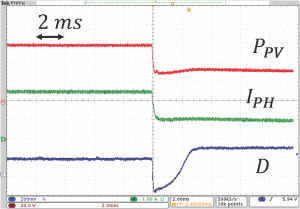Solar Variability Reduction in Solar Arrays Using OFF-MPP Tracking and Energy Storage Systems
Jason Galtieri with advisor P.Krein
Maximum power point (MPP) tracking is the standard control scheme for photovoltaic (PV) arrays of all sizes. Inverter tracking algorithms work on second to sub-second time scales and can track most naturally occurring irradiance changes, such as moving cloud coverage. Fast response tracking imposes large power swings on the grid which must be absorbed in spinning reverses. As PV penetration increases and replaces traditional spinning generation, there is concern the grid’s voltage and frequency stability could be compromised.
For practical scenarios, MPPT maximizes the variability a PV array imposes on the grid and minimizes the amount of control provided to the array operator and/or utility. The MPP is determined entirely by the amount of available irradiance, which can be difficult or error-prone to forecast ahead. To date, active array control has mainly taken the form of curtailment during periods of overproduction, but these methods are relatively slow and limited. In our work, off-MPP set-point strategies are proposed which use ripple correlation control (RCC) to quickly find the MPP current and voltage. The MPP data is then fed into an off-MPP setpoint controller to operate at a reduced set point. RCC algorithms converge in millisecond timeframes, so the MPP data can be updated several times a second to maintain accuracy. Likewise, the off-MPP converters converge on similar time-scales, so the converters spend most of their time at the reduced set-point. Figure 1 shows experimental results for an RCC controller which will provide the foundation for the setpoint algorithm. The controller is connected to a 100 W PV panel and subjected to a step change in input power. The RCC converter converges in less than 3 milliseconds, making it one of the fastest MPPTs available. This research is supported by the Grainger Center for Electric Machinery and Electromechanics.
